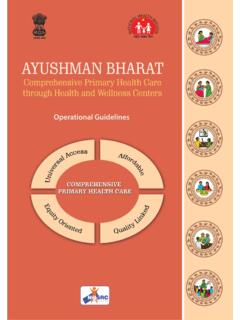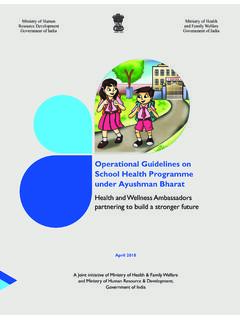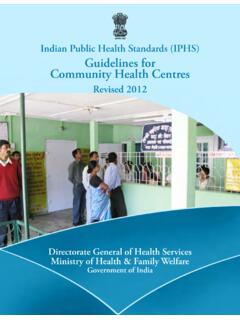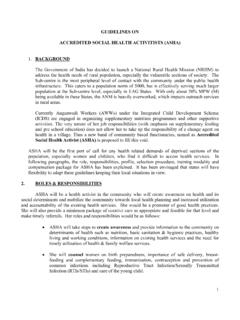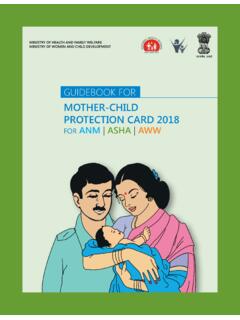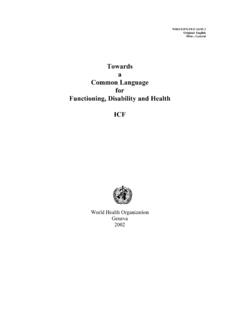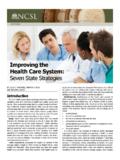Transcription of Rural Health Care System in India - NHM
1 1 Rural Health care System in India Rural Health care System the structure and current scenario The Health care infrastructure in Rural areas has been developed as a three tier System (see Chart 1) and is based on the following population norms: Table 1. Centre Population Norms Plain Area Hilly/Tribal/Difficult Area Sub-Centre 5000 3000 Primary Health Centre 30,000 20,000 Community Health Centre 1,20,000 80,000 Sub-Centres (SCs) The Sub-Centre is the most peripheral and first contact point between the primary Health care System and the community. Each Sub-Centre is required to be manned by at least one Auxiliary Nurse Midwife (ANM) / Female Health Worker and one Male Health Worker (for details of staffing pattern, see Box 1 and for recommended staffing structure under Indian Public Health Standards (IPHS) see Annexure I).
2 Under NRHM, there is a provision for one additional second ANM on contract basis. One Lady Health Visitor (LHV) is entrusted with the task of supervision of six Sub-Centres. Sub-Centres are assigned tasks relating to interpersonal communication in order to bring about behavioral change and provide services in relation to maternal and child Health , family welfare, nutrition, immunization, diarrhoea control and control of communicable diseases programmes. The Sub-Centres are provided with basic drugs for minor ailments needed for taking care of essential Health needs of men, women and children. The Ministry of Health & Family Welfare is providing 100% Central assistance to all the Sub-Centres in the country since April 2002 in the form of salary of ANMs and LHVs, rent at the rate of Rs.
3 3000/- per annum and contingency at the rate of Rs. 3200/- per annum, in addition to drugs and equipment kits. The salary of the Male Health Worker is borne by the State Governments (Also see para for NRHM additionalities). Under the Swap Scheme, the Government of India has taken over an additional 39,554 Sub Centres from State Governments / Union Territories since April, 2002 in lieu of 5,434 Rural Family Welfare Centres transferred to the State Governments / Union Territories. There are 1,48,124 Sub Centres functioning in the country as on March 2011. Number of Sub Centres existing as on March 2011 increased from 146026 in 2005 to 148124 in 2011.
4 There is significant increase in the number of Sub Centres in the States of Chhattisgarh, Haryana, Jammu & Kashmir, Karnataka, Maharashtra, Orissa, Punjab, Rajasthan, Tamil Nadu, Tripura and Uttarakhand. As on March, 2011, there are 148124 Sub Centres, 23887 Primary Health Centres (PHCs) and 4809 Community Health Centres (CHCs) functioning in the country 2 Primary Health Centres (PHCs) PHC is the first contact point between village community and the Medical Officer. The PHCs were envisaged to provide an integrated curative and preventive Health care to the Rural population with emphasis on preventive and promotive aspects of Health care .
5 The PHCs are established and maintained by the State Governments under the Minimum Needs Programme (MNP)/ Basic Minimum Services (BMS) Programme. As per minimum requirement (Box-1), a PHC is to be manned by a Medical Officer supported by 14 paramedical and other staff (See Annexure-I for IPHS norms). Under NRHM, there is a provision for two additional Staff Nurses at PHCs on contract basis. It acts as a referral unit for 6 Sub Centres and has 4 - 6 beds for patients. The activities of PHC involve curative, preventive, promotive and Family Welfare Services. (Also see para for NRHM additionalities).
6 There were 23,887 PHCs functioning in the country as on March 2011. Community Health Centres (CHCs) CHCs are being established and maintained by the State Government under MNP/BMS programme. As per minimum norms (Box-1), a CHC is required to be manned by four Medical Specialists Surgeon, Physician, Gynecologist and Pediatrician supported by 21 paramedical and other staff (See Annexure-D for IPHS norms). It has 30 in-door beds with one OT, X-ray, Labour Room and Laboratory facilities. It serves as a referral centre for 4 PHCs and also provides facilities for obstetric care and specialist consultations (Also see para for NRHM additionalities).
7 As on March, 2011, there are 4,809 CHCs functioning in the country. The details of the population norms for each level of Rural Health infrastructure and current status against these norms are given in Box 2. First Referral Units (FRUs) An existing facility (district hospital, sub-divisional hospital, community Health centre etc.) can be declared a fully operational First Referral Unit (FRU) only if it is equipped to provide round-the-clock services for Emergency Obstetric and New Born care , in addition to all emergencies that any hospital is required to provide. It should be noted that there are three critical determinants of a facility being declared as a FRU: i) Emergency Obstetric care including surgical interventions like Caesarean Sections; ii) New-born care ; and iii) Blood Storage Facility on a 24-hour basis.
8 At the national level, there is an increase of 651 PHCs in 2011 as compared to that existed in 2005. Significant increase is observed in the number of PHCs in the States of Andhra Pradesh, Assam, Bihar, Chhattisgarh, Haryana, Jammu & Kashmir, Karnataka, Maharashtra, Nagaland, Uttarakhand andUttar Pradesh At the national level there is an increase of 1463 CHCs in 2011 as compared to that existed in 2005. Significant increase is observed in the number of CHCs in the States of Arunachal Pradesh, Chhattisgarh, Gujarat, Haryana, Himachal Pradesh, Jammu & Kashmir, Jharkhand, Karnataka, Kerala, Madhya Pradesh, Punjab, Odisha, Rajasthan, Tamil Nadu, Uttarakhand, Uttar Pradesh and West Bengal 3 Chart 1.
9 2. Strengthening of Rural Health Infrastructure Under National Rural Health Mission The National Rural Health Mission (2005-12) seeks to provide effective healthcare to Rural population throughout the country with special focus on 18 states, which have weak public Health indicators and/or weak infrastructure. These 18 States are Arunachal Pradesh, Assam, Bihar, Chhattisgarh, Himachal Pradesh, Jharkhand, Jammu & Kashmir, Manipur, Mizoram, Meghalaya, Madhya Pradesh, Nagaland, Orissa, Rajasthan, Sikkim, Tripura, Uttarakhand and Uttar Pradesh. The Mission is an articulation of the commitment of the Government to raise public spending on Health from of GDP to 2-3% of GDP.
10 NRHM aims to undertake architectural correction of the Health System to enable it to effectively handle increased allocations as promised under the National Common Minimum Programme and promote policies that strengthen public Health management and service delivery in the country. It has as its key components provision of a female Health activist in each village; a village Health plan prepared through a local team headed by the Health & Sanitation Committee of the Panchayat; strengthening of the Rural hospital for effective curative care and made measurable and accountable to the community through Indian Public Health Standards (IPHS); integration of vertical Health & Family Welfare Programmes, optimal utilization of funds & infrastructure, and strengthening delivery of primary healthcare.
